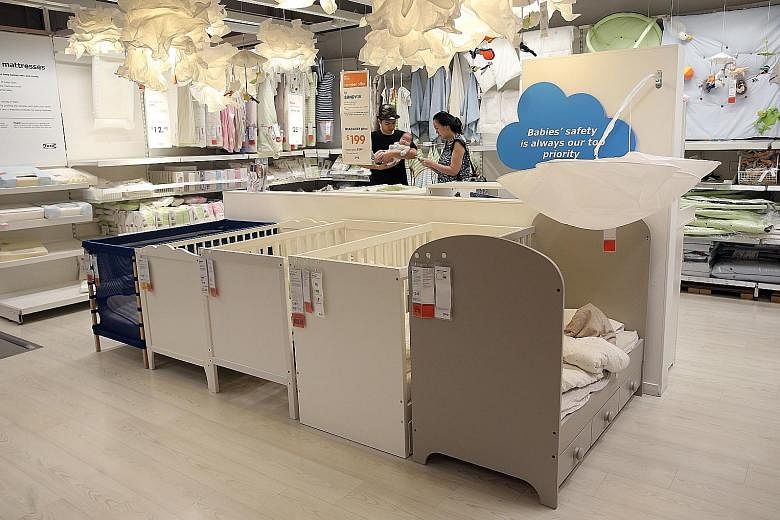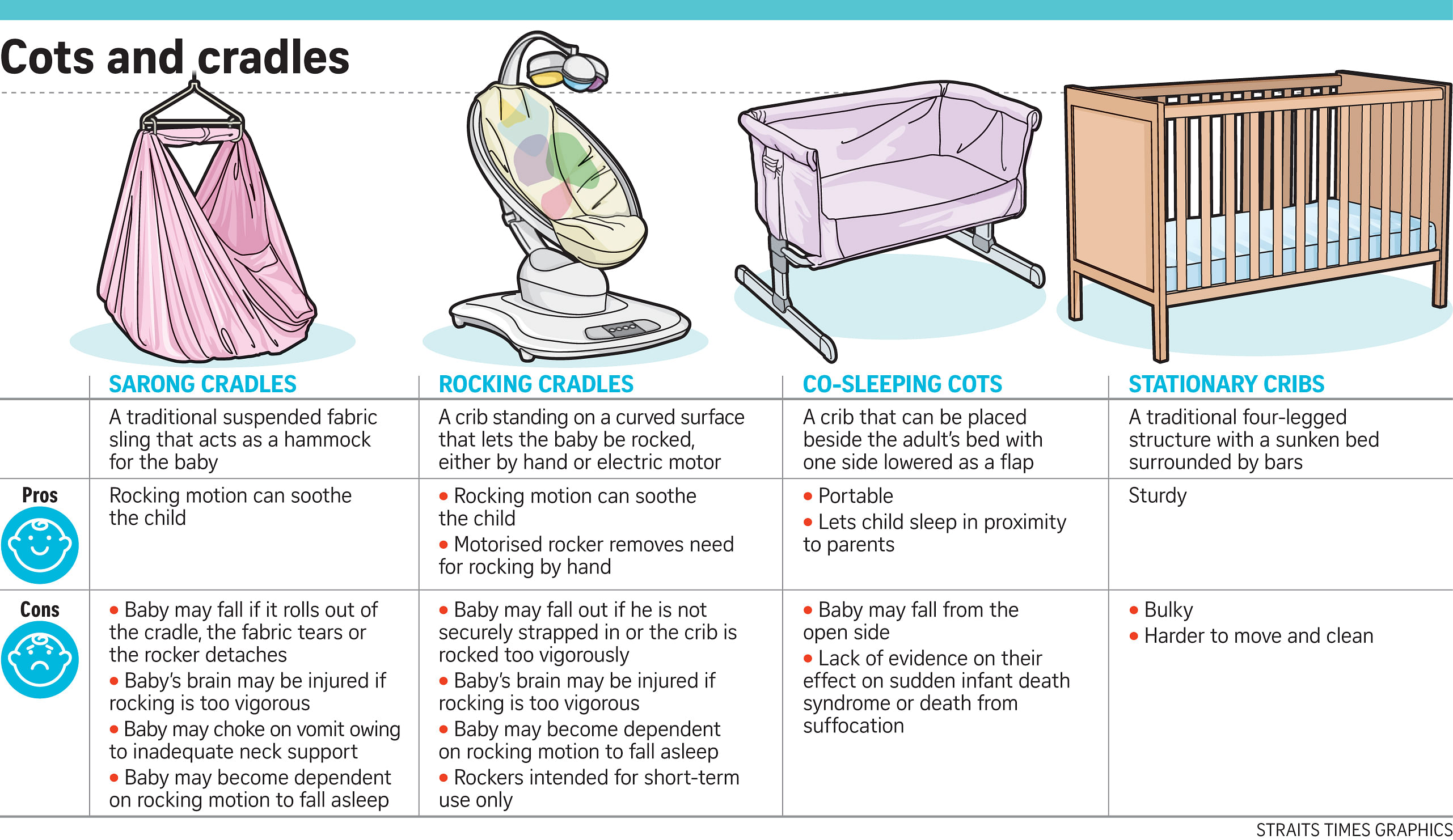Gone are the days when caregivers relied on the sarong cradle to soothe a newborn child.
Parents now have a dazzling array of bedtime options for their babies - from cots that can be placed beside an adult bed with one side lowered to self-rocking electronic cradles.
Still, experts say the safest option is neither a co-sleeping cot nor a sarong cradle. It is a traditional crib with a firm mattress, with no drop sides or wide gaps between slats.
Associate Professor Song Kee Hong from the National University of Singapore's School of Design and Environment said: "Most cribs should be safe under normal conditions. But poorly designed cribs with drop sides have been known to cause accidental strangulation deaths.
In 2011, the United States banned the sale of drop-side cribs amid safety concerns, as babies could get trapped - sometimes fatally - in the gaps created if the drop sides came loose.
In Britain, there was a public outcry in 2015 after a seven-week-old infant died from asphyxiation when her neck was caught on the edge of her crib's folding side.
Dr Petrina Wong, a paediatric consultant at KK Women's and Children's Hospital, said the American Academy of Paediatrics has no guidelines on the use of co-sleeping products as there is a lack of evidence on their effect on sudden infant death syndrome or the risk of unintentional injury and death from suffocation.
NEW DESIGNS POPULAR
Still, retailers said such newfangled options are popular with parents because they are versatile.
-
Train baby to fall asleep independently
-
Exhausted new parents, sinking into bed after a long day, may quickly learn to dread their baby's midnight wails.
But experts say such crying is normal and parents must learn to let babies get into a healthy sleep cycle.
Infants have different sleeping needs from adults and many manage to sleep through the night only from around the nine-month mark.
During their first year, babies will spend most of the day sleeping and this can range from 14 to 20 hours. Much of this is rapid eye movement (REM) sleep, which experts believe is necessary for infant development. So babies will stir more easily.
"It is normal for babies to wake up intermittently in the night and go back to sleep spontaneously," said Dr Mahesh Babu Ramamurthy, head and senior consultant of National University Hospital's paediatric pulmonary and sleep division.
Dr Petrina Wong, a paediatric consultant at KK Women's and Children's Hospital (KKH), said that while the baby is asleep, he may smile, grimace or make a sucking action, and his fingers and feet may twitch occasionally. "An older infant may wake up at night to pull himself up to stand or practise newfound skills," she added.
Babies should be able to sleep for 10 to 12 hours at night from when they are three to four months, said Dr Janice Wong, a paediatrician with Thomson Paediatric Centre.
They may wake up once or twice and need to be fed or have their diapers changed. Once babies are able to sleep through the night, they will still need daytime naps - each lasting two to three hours - until the age of three or so.
KKH's Dr Wong said: "When a baby starts to have a regular sleep-wake cycle and does not require night feedings, this may be the right time to start sleep training." Sleep training refers to giving babies a routine to fall asleep consistently and independently.
Mrs Emeline Hare, 41, a post-partum "doula", or mother's companion, with more than 10 years of childcare experience, said: "I'm a firm believer in the need to give our children indicators about bedtime, such as creating a routine that shows them love, and gives them security and confidence to fall asleep independently."
These bedtime cues include feeding the baby, dimming the lights and reading a bedtime story before putting him to bed.
"We create a ritual by doing the same thing and being very repetitive, so he knows what's happening," she said, adding that this helps babies feel secure and fall asleep more readily.
But Dr Mahesh cautioned that, while caregivers can keep drowsy babies company, "they should let the baby go to sleep on his own".
He said: "It is common for parents or grandparents to fall into the habit of rocking the baby and feeding him to sleep, and so forth. These habits are extremely difficult to break."
Annabeth Leow
Vendors whose inventory features only stationary cribs, such as Ikea, also offer cribs which can "grow" with a child.
The Swedish furniture retailer's Stuva and Sundvik cots have bases that can be placed at different heights to match that of a growing child. One side of the cot can be removed entirely to convert it into a toddler bed.
Mrs Rachel Goh, 29, a primary school teacher, has a similar crib for her seven-month-old daughter.
She likes the convenience of being able to lower one side of the crib, as this allows her to pick up her daughter in a less strenuous way. She also likes the idea that it can be used for several years.
Meanwhile, the bestsellers at online retailer Pupsik Studio include bedside cribs for co-sleeping infants, electronic rockers and nest beds, said director Su Ling Zagorodnova. Sales of traditional wooden cots and travel cots are "more lukewarm", she added.
A nest bed is a portable, basket- like bassinet that holds baby inside and lets him sleep safely beside his parents. "Portability, convenience and multi-functionality are high priority for parents," she said.
Mr Pang Fu Wei, managing director of baby product store Mothercare, said: "Products with longer lifespans, such as cot beds and co-sleeping solutions, are trendy."
Still, he said, rockers are meant for temporary use and should not replace a baby's regular bed.
This falls in line with the advice of child experts. Dr Mahesh Babu Ramamurthy, head and senior consultant of National University Hospital's paediatric pulmonary and sleep division, said: "Rocking cradles and sarong cradles are not recommended since they can inculcate a sleep association and the infant will be able to sleep only in the same environment later on."
DANGERS AND PRECAUTIONS
Dr Janice Wong, a paediatrician with Thomson Paediatric Centre, said babies might roll out of the sarong cradle or self-rocking cradle and hurt themselves. "Parents should strap their babies securely" if an electronic rocker is used.
Other dangers include babies choking to death on their vomit if the product - like a sarong cradle - does not provide enough support for their heads, or getting brain damage from rocking that is too vigorous.
Dr Wong said: "Proper sleeping cots are still recommended and it is best if they are placed beside the adult's bed. If the cot must be in another room, use a baby monitor."
When it comes to choosing cots, parents should seek reputable retailers and ensure that products come with clear safety instructions. The latter is especially important for those buying second-hand cots or using hand-me-downs.
A spokesman for Spring Singapore, the government product- safety watchdog, said it conducts post-market surveillance on products, including those for children, such as cots, strollers and toys. This is "to ensure the products are safe".
Last year, Spring recalled three baby cots as tests showed that the products did not meet safety standards. The three cribs also lacked the required instruction materials.
The spokesman said that parents should check that the products are age-appropriate and ensure that children are supervised during use.
Avoid giving your baby stuffed toys, pillows and other loose items as there is a risk of suffocation, especially to babies younger than five months who cannot yet roll and push items away.
These objects are also not safe for older babies as they may use them to clamber out of the cot.
Firm mattresses are good as they reduce the danger of suffocation. They should lie flush against the edges of the cot so that your baby does not get trapped in a gap.
The experts also recommend cribs with slats no bigger than 4.5cm to 6cm to prevent babies from slipping through.
Correction note: The sidebar has been edited to correct the pronoun for Dr Mahesh to he. We are sorry for the error.



